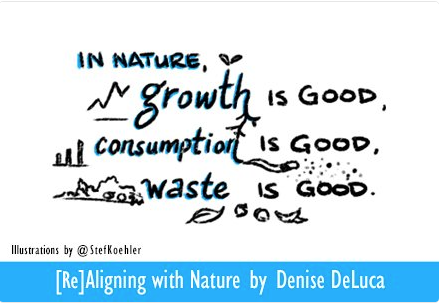By Erin Connelly
What if business as usual didn’t have to be so…usual? In Denise DeLuca’s new book, “Re-Aligning With Nature: Ecological Thinking for Radical Transformation,” she explores how true change – on personal, company-wide, and societal levels – can’t happen unless we “realign what we do, how we do it, and why we do it, with nature and with our own human nature.”
I had a chance to ask Denise some questions about the book’s premise, the “aha” moments that led to her to write it, and how we can take steps to re-align ourselves with nature in our everyday lives.
 Tell me more about why you say that nature-inspired design doesn’t fit in “the real world.”
Tell me more about why you say that nature-inspired design doesn’t fit in “the real world.”
Erin, you and the crew at the Biomimicry Institute know better than most that the goal of biomimicry, nature-inspired design, is sustainable and perhaps biophilic design. We know that the strategies and solutions we can find in nature are incredible. By our own technical standards, they are radically innovative. By our environmental standards, they are the very definition of sustainability. And they can also be beautiful and evoke our sense of biophilia, our innate love of nature. So nature-inspired design is radically innovative and sustainable and often beautiful and inspiring, too.
Now let’s consider “the real world.” Think about the last time you heard or used that expression. How was it used? What was it referring to? What kind of a worldview did it represent? I don’t know about you, but when I hear that expression, it conjures up an image of men in suits with folded arms and furrowed brows making power decisions that will make or break you. It’s a world based on money — making and taking as much as you can. It’s full of brick walls and dead ends. It’s ruthless. It’s not very nice!
Maybe I’m being too harsh, but consider someone, or much more likely a co-creative team of someones, has come up with a nature-inspired design and wants to get it out in the world. When they share their design with others, many people will be excited and supportive but inevitably they will hear, “That’s cool, but it will never work in the real world.” Or, when they get their first few rejections, they’ll hear “Welcome to the real world.” Anyone who has tried to take a nature-inspired radical sustainable innovation beyond the ideation stage has likely run into that expression – into those seemingly endless brick wall and dead ends.
That’s because what we all call “the real world” is constructed with top-down hierarchies where risks are pushed down and rewards are pulled up. It’s filled with silos, where systems thinking and co-creativity are all but impossible. The metric of success is money, and the goal is to make as much as possible as fast as possible – for yourself. That’s “the bottom line”, right? The construct and the culture of the real world just isn’t set up to measure and manage radical innovation, let alone nature-inspired sustainable and biophilic design.
That’s the bad news. The good news, what I hope to share in the book, is that we can apply the tools of biomimicry to “the real world” to help it foster and forward nature-inspired design, and in the process, make “the real world” more adaptable, more resilient, more sustainable, more human – like nature, the REAL real world.
In the book, you posit that anthropocentrism is actually a good thing. Why is that?
Anthropocentrism refers to “considering human beings as the most significant entity of the universe,” or “interpreting or regarding the world in terms of human values and experiences” (that’s what the dictionary says).
In the world of sustainability, we assume that anthropomorphism is bad because it has resulted in things like toxic waste, environmental destruction, and climate change. Because of these very bad results, we also tend to assume the actions that caused them are bad: taking natural resources for our own benefit, consuming whatever we can get our hands on, generating waste while being thoughtless about disposal. Fair enough.
But now let’s consider worms, like the ones that live in our compost piles and gardens. Worms take natural resources for their own benefit, consume whatever they can get their “hands” on, and generate waste while being thoughtless about disposal. And we’re so glad they do! The world depends on it. Worms are “oligochaeto-centric” (I can’t even say that word!). They can’t help but interpret or regard the world in terms of worm values and worm experiences. Ditto with all organisms; however, with all other (non-human) organisms, the net results are good.
If we humans can figure out how to generate net positive results in the world while being self-interested, then the anthropocentrism that comes naturally to us could be good, too. Of course biomimicry, applied to both technical and social innovation, can help get us there, but I believe it’s going to take a paradigm shift – what I’m calling re-aligning with nature – to make that happen.
You are challenging a lot of things in this book, including some of the fundamental tenets of sustainability. Can you talk about that?
We keep framing sustainability in conventional terms – ecosystems services and triple bottom line – and it just isn’t working, at least not at the scale and speed needed.
I’m an engineer by training and have worked in sustainability for a long time. In engineering, we often focus on efficiency – efficiency is good. People forwarding sustainability like to say that nature is efficient, which is true, but not the way we measure efficiency, with one metric at a time, one device or isolated subsystem at a time. This has led to so many unintended consequences as well as missed opportunities. We need to reframe our thinking.
People also like to say that in nature, everything is local – and local is good. Again, that is true, but it is also true that nature’s systems are global as well as galactic and a universal. Heck, we are totally reliant in the sun, and it’s almost 100 million miles away! Again, we need to reframe our thinking.
Did you have ‘aha’ moments that led you to create this book?
Yes, actually a series of ah-ha moments that I felt all fit together somehow.
One is that sustainability can only be achieved through radical thinking and radical innovation. Incremental innovation alone will never get us there. Everything I’ve learned about the challenges of generating and forwarding radical innovation applies to sustainability, and vice versa. I saw biomimicry as the link, but it wasn’t quite there yet.
Another is that sustainability is about making it possible for humans and nature to exist and to co-exist. So many sustainability frameworks and technologies are spot-on, but there always seems to be something missing. The ‘aha’ moment was when I realized that the missing link between humans and nature is human nature.
I’ve been teaching biomimicry for years, with the intent of training people how to connect with nature, understand nature’s rules for sustainability, and ultimately create sustainable innovations. But at one point I realized that while learning how to practice biomimicry, people experience curiosity, creativity, openness, trust, and emergent thinking – all at once, and with other people, and sometimes for the first time in their adult lives. It is tremendously wonderful and powerful, sometimes overwhelming. I have come to believe that what is going on is that they are experiencing a re-aligning of their own human nature with nature, and this tremendous wonderful potential could be tapped to solve the world’s problems.

How can re-aligning with nature help businesses who, frankly, have to focus on the bottom line?
It is no secret to business that change is happening, that change needs to happen, and that failure to change equals failure, yet most organizations are resistant change. By adopting communication and collaboration practices inspired by nature, organizations reap immediate benefits while becoming more agile, more adaptable, and more innovative. Imagine if learning a few new practices could drastically reduce time and energy spent with complaints and conflicts? Gallup polls suggest that 70% of workers are disengaged. Imagine the productivity gains if 100% of workers were engaged 100% of the time?
How can we enhance the elements in the natural paradigm in our lives? What’s a baby step we can take to get us further towards re-aligning with nature?
It’s funny you ask this. Right before the book went to print, the publisher called and said he had chatted with Francesca Bertone, wife of Jay Harman (author of The Shark’s Paintbrush) and COO of PAX Scientific (maker of the biomimetic Lily Impeller). She read the book and said that she wanted more, that she wanted to know what she and others could do. So I wrote the epilogue.
What I suggest is that you start by simply noticing how the elements of the conventional and natural paradigms play out in your world. As you do, imagine if you, or others, expressed more of the natural paradigm. What would that look like? What might happen?
Then take that baby step of by actually acting according to your natural paradigm, rather than your conventional paradigm, in little ways, here and there, where it feels safe. For example, when you feel fear (or stress or anger) try to express curiosity. Try responding with the words “I wonder …” When you feel scarcity (not enough time or money, for example), think about what you have in abundance (inspiration and imagination, leaves and love) and figure out how to leverage those things to achieve the outcomes you desire.
You can start by doing this in your own head, then try doing it with others. Notice how it makes you feel, how others respond, how things play out. Over time, you can start doing these things with intention, and helping others do the same.
It might sound crazy to some people, but the point is you already do these things – when you’re not engaged in “the real world.” It’s how you are and what you do when you’re with people you love – and in nature. As I say in the book, it’s only natural!
To learn more about the book, you can take a look at realingingwithnature.com.

